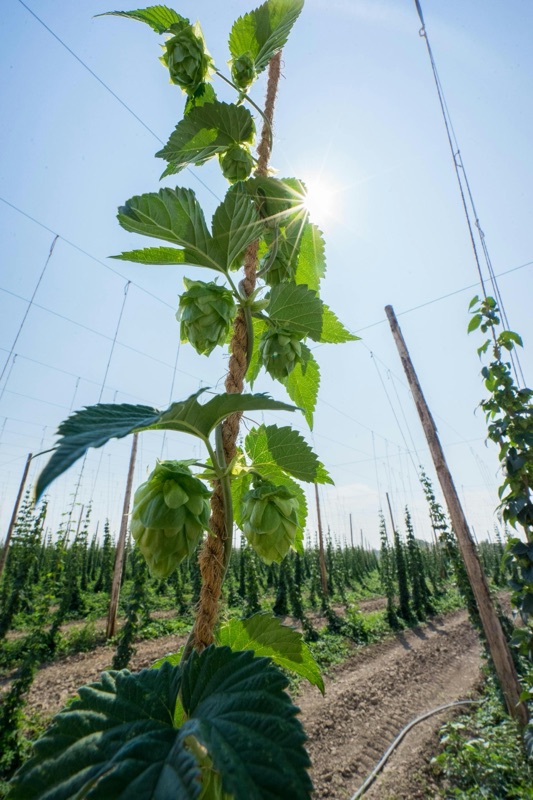Botanical Basics
- Common Name(s): Hops
- Folk Name(s): Hop Vine, Beer Flower, Lupulin
- Scientific/Latin Name: Humulus lupulus
- Family: Cannabaceae (same family as hemp and cannabis)
- Plant Type: Hardy perennial, climbing bine (not a true vine)
- Botanical Description: Fast-growing bine with rough, twining stems that climb by wrapping clockwise. Leaves are opposite, lobed, rough-textured. Flowers are dioecious (male and female separate); female flowers form cone-like catkins (strobiles) that contain lupulin glands, producing aromatic resins and essential oils.
- Growing Zones/Climate: USDA Zones 3–8
- Best Zones for Growth: Cool to temperate climates with long summer days (Pacific Northwest USA, parts of Europe)
- Habitat & Range: Native to Europe, Western Asia, and North America; naturalized widely in riverbanks, hedgerows, and woodlands
Cultivation & Harvest
- Soil & Sun Requirements: Deep, well-drained sandy loam; rich in organic matter; prefers full sun and consistent moisture
- Propagation: By rhizome division, crown cuttings, or rootstock; rarely grown from seed for cultivation due to variability
- Companion Planting: Benefits from tall supports; sometimes paired with grapes or sunflowers; attracts beneficial insects
- Harvesting Guidelines: Female cones harvested in late summer to early fall when aromatic and papery; picked by hand or cut from bines
- Drying/Preservation: Cones are quickly dried at low temperatures to preserve volatile oils, then stored airtight; can also be pelletized for brewing
Traditional & Historical Use
- Cultural Significance: Best known for centuries as the bittering and flavoring agent in beer; associated with fertility and festivity in European folklore
- Traditional Medicine: Used as a sedative, digestive bitter, and anti-inflammatory; often combined with valerian for sleep disorders
- Symbolism: Represents relaxation, banishment of worry, fertility, and celebration
Medicinal & Practical Properties
- Active Constituents: Bitter acids (humulone, lupulone), essential oils (myrcene, humulene), flavonoids (xanthohumol), phytoestrogens
- Medicinal Uses:
- Mild sedative for insomnia and restlessness
- Bitter tonic for digestion and appetite stimulation
- Anti-inflammatory and antimicrobial properties
- Relief of menopausal symptoms (phytoestrogenic action)
- Preparation Methods: Teas, tinctures, hop pillows for sleep, extracts, bitters formulations, brewing in beer
- Dosage & Guidelines:
- Infusion: 1–2 tsp dried hops per cup boiling water, steeped 10–15 min, 2–3 times daily
- Tincture: 1–2 mL up to 3 times daily
- Hop pillow: stuffed dried hops for calming effect during sleep
- Safety/Precautions: May cause allergic reactions in sensitive individuals. Contraindicated in severe depression (may worsen). Avoid during pregnancy due to estrogenic effects.
Magical & Spiritual Properties
- Elemental Association: Water
- Planetary/Deity Correspondence: Venus (love, relaxation, fertility); linked to Bacchus/Dionysus (wine, revelry)
- Magical Correspondences: Sleep, rest, banishing sorrow, healing, fertility, dream magic
- Ritual Use: Added to sleep sachets, charm bags, and dream pillows; used in ritual beers or offerings for festivity and abundance
- Symbolism in Divination/Dreams: Indicates a need for rest, balance, letting go of stress; may signal fertility or creative brewing of new ideas
Ecological & Culinary Uses
- Pollinator Value: Male flowers attract bees and other insects
- Wildlife Uses: Dense bines provide cover for birds and small mammals
- Culinary Uses:
- Primary use in brewing beer for bitterness, aroma, and preservation
- Occasionally used in bitters, flavor extracts, or as a seasoning in small amounts
- Young shoots are edible, cooked like asparagus in some traditions
Household/Practical Uses
- Quick Uses: Hop pillow for sleep, bitter tea for digestion, brewing for beer
- Notable Traits: One of the fastest-growing plants (up to a foot per day in peak season); long history as both medicine and brewing herb
- Special Notes: Symbol of both festivity and rest—used for calming and for celebration

Supporting Notes
- Chevallier, Andrew. Encyclopedia of Herbal Medicine (2016)
- Grieve, M. A Modern Herbal (1931)
- Buhner, Stephen Harrod. Sacred and Herbal Healing Beers (1998)
- Duke, James A. Handbook of Medicinal Herbs (2002)
- EMA (European Medicines Agency). “Humulus lupulus L., flos (Hops)” Monograph (2014)
No comments:
Post a Comment